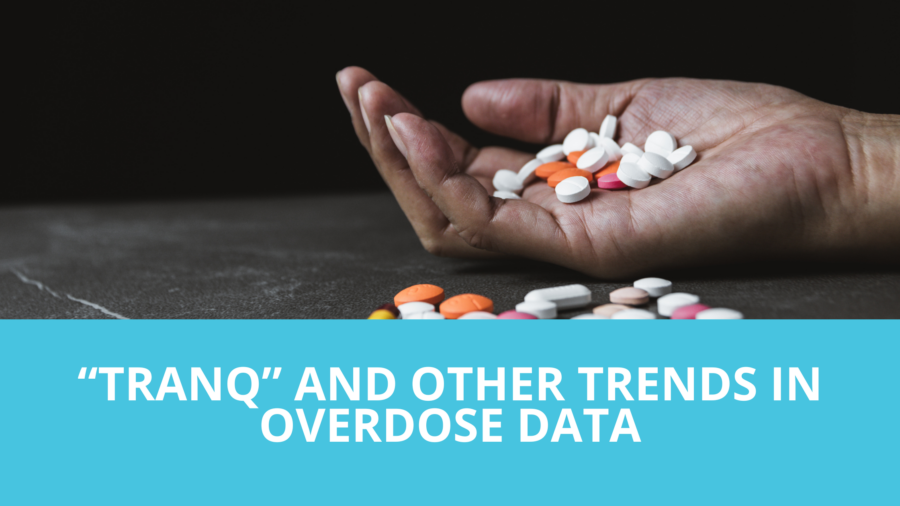In recent years, the dangers of widespread opioid drug use have been further complicated with the infiltration of additional licit and illicit substances.
“According to the Centers for Disease Control and Prevention (CDC), the number of drug overdose deaths increased by nearly 30% from 2019 to 2020 and has quintupled since 1999. Nearly 75% of the 91,799 drug overdose deaths in 2020 involved an opioid. From 2019 to 2020, there were significant changes in opioid-involved death rates. Specifically, the CDC found that:
- Opioid-involved death rates increased by 38%.
- Prescription opioid-involved death rates increased by 17%.
- Heroin-involved death rates decreased by 7%.
- Synthetic opioid-involved death rates (excluding methadone) increased by 56%.” 1
This data suggests an uptick in opioid overdose deaths due to exposure to both prescribed and illicitly manufactured substances. However, one of the most potentially impactful trends is the 56% increase in opioid-involved deaths related to synthetic opioids. Synthetic opioids are a group of substances which include federally regulated medications approved for human use as well as those that are not approved for human use.
Examples of FDA approved synthetic opioids include: fentanyl, methadone, and tramadol. Since 2013, there has been a distinct rise in opioid overdose deaths involving synthetic opioids, particularly those involving illicitly manufactured fentanyl.1 Most recent cases of fentanyl-related harm, overdose, and death in the U.S. are linked to illegally made fentanyl.3
Unregulated synthetic opioids are opioids that have no approved human use. These substances are considered very dangerous when consumed and are often less studied than regulated synthetic opioids. Included in this group are fentanyl analogs: carfentanil, acetyl fentanyl, fluorofentanyl, and non-fentanyl opioids including isotonitazene and metonitazene, examples of a class called nitazenes.
Often these substances are mixed with other illicit substances, or made to look like prescription medications, or made to look like prescription medications, so users may be unaware of what they were exposed to or how much. This further complicates the identification, regulation and treatment of exposure to these dangerous substances.
A recent dangerous drug combination that has captured federal attention is fentanyl mixed with xylazine.
“Xylazine is making the deadliest drug threat our country has ever faced, fentanyl, even deadlier,” said Administrator Milgram. “DEA has seized xylazine and fentanyl mixtures in 48 of 50 States. The DEA Laboratory System is reporting that in 2022 approximately 23% of fentanyl powder and 7% of fentanyl pills seized by the DEA contained xylazine.”2
As of April 12, 2023, Dr. Rahul Gupta, Director of the White House Office of National Drug Control Policy (ONDCP), has officially designated fentanyl adulterated or associated with xylazine as an emerging threat to the United States. This designation comes after careful review of the impact of xylazine on the opioid crisis, including its growing role in overdose deaths in every region of the United States.6 While the full national scope of overdose deaths involving xylazine is unknown, research shows overdose deaths linked to xylazine have spread westward across the United States, with the largest impact in the Northeast. From 2015 to 2020, the percentage of all drug overdose deaths involving xylazine increased from 2% to 26% in Pennsylvania. Xylazine was involved in 19% of all drug overdose deaths in Maryland in 2021 and 10% in Connecticut in 2020.4
Xylazine is an alpha-2 adrenergic receptor agonist in the same drug class as clonidine, lofexidine, and dexmedetomidine. It was initially studied for use in humans as an antihypertensive agent, but development for human use was discontinued because of adverse effects. Xylazine was approved by the Food and Drug Administration for use as a sedative in veterinary medicine in 1972 but isn’t approved for use in humans.1 In published animal studies, xylazine decreased the release of norepinephrine and dopamine in the CNS. According to the FDA-approved product label for veterinary use, xylazine has an onset of action within 10 to 15 minutes after intramuscular injection in animals. A sleeplike state, the depth of which is dose-dependent, is usually maintained for 1 to 2 hours, while analgesia lasts from 15 to 30 minutes. The centrally acting muscle relaxant effect causes relaxation of the skeletal musculature, complementing sedation and analgesia.5
The opioid epidemic is evolving, and the medical industry at all levels can play a part in combating this wide scale health issue. Changes in opioid overdose death rates and the inclusion of non-opioid substances highlight the need to increase knowledge and awareness on the dynamic nature of the overdose epidemic.
At Genesis we offer a variety of ordering options to allow for testing tailored to the individual needs of each patient and clinical education for our clients on emerging trends in substances of abuse.
Our confirmatory testing utilizing LC-MS/MS technology allows for the identification and quantification of many substances of concern, including pain medications such as fentanyl, oxycodone, morphine, and tramadol, as well as many emerging drugs of abuse (fentanyl analogs, designer benzodiazepines, synthetic cannabinoids and xylazine) reflecting modern toxicological concerns.
For more information about Genesis Reference Laboratories toxicology testing services, please reach out to your local Genesis representative.
References
- https://www.cdc.gov/opioids/basics/epidemic.html
- https://www.dea.gov/alert/dea-reports-widespread-threat-fentanyl-mixed-xylazine
- https://www.cdc.gov/opioids/basics/fentanyl.html
- https://nida.nih.gov/research-topics/xylazine
- https://www.deadiversion.usdoj.gov/drug_chem_info/Xylazine.pdf
- https://www.whitehouse.gov/ondcp/briefing-room/2023/04/12/biden-harris-administration-designates-fentanyl-combined-with-xylazine-as-an-emerging-threat-to-the-united-states/

